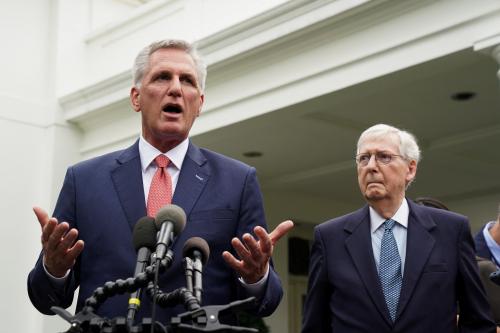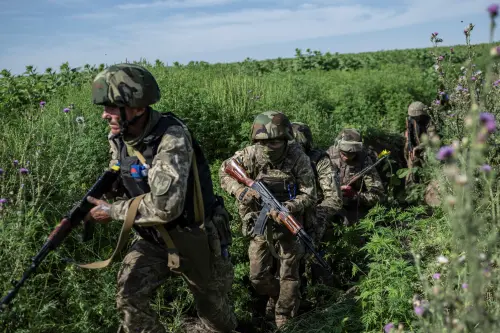Skeptics of U.S. support for Ukraine in its fight for survival against Russia often sound callous, strategically naive, or both. But they are right to question the Biden administration’s approach to the war. Saying we’ll help Ukraine “for as long as it takes” is more of a slogan or exhortation than a strategy, especially as time goes by.
Would we really provide more than $50 billion a year in U.S. aid (with Europeans collectively providing at least as much, counting financial and humanitarian assistance too) indefinitely — regardless of battlefield trends and other factors? Helping Ukraine survive, and ultimately recover, as a nation should be an ironclad principle guiding U.S. thinking. But maintaining Marshall Plan-like levels of aid, as far as the eye can see, to help Ukraine recover every part of its Russian-occupied territory is another matter.
That said, it is too soon to restrict or scale back aid. Indeed, at this juncture, it should be increased in quantity and quality. Ukraine deserves a further chance to win back as much of the 17% of its territory that Russian President Vladimir Putin has, for now, stolen. It has not yet had enough of a chance, because it has only possessed weapons like Western tanks for a few months, and because there are other weapons like long-range precision missiles and fighter aircraft that the West has not yet provided in adequate numbers. Moreover, Russia is showing no signs of interest in any diplomacy or compromise at present. To pressure Ukraine to make concessions or scale back its goals in the face of such Russian intransigence would only encourage Putin to think time is on his side and continue the fight while maximizing his own goals.
As strategists including retired General David Petraeus and Fred Kagan, retired General Jack Keane, and Max Boot have rightly argued, it is also too soon to declare Ukraine’s 2023 offensive a failure or to assume that the military stalemate will persist. Ukraine is advancing hundreds of meters a day in some sectors of the 600-mile front. At such a rate, to be sure, it will struggle to claw back its lost lands on any reasonable timetable. But the possibility exists that, once several of their lines of trenches, fortifications, and minefields are penetrated, tired Russian troops will crack, or lack enough reserves to plug any holes in their defenses. Ukrainian breakthroughs could then result. That might not be enough to win the war outright, but even if breakthroughs proved limited in scope, they could change the territorial situation substantially.
I confess that my confidence in such a breakthrough scenario is limited, even after a recent trip to Kyiv that highlighted many impressive trends in the Armed Forces of Ukraine. But war is unpredictable, and some promising developments are underway on the battlefield. There can also be little doubt that Ukrainians are remarkably unified in their efforts to keep up the fight. Indeed, it is evident that they want all their land back — including the Crimean Peninsula, seized by Russia back in 2014 — even if doing so would take years. They also want, naturally, to liberate their fellow citizens now living under often brutal Russian rule in the occupied lands.
I am not suggesting that we be quite that patient ourselves. There are huge risks and costs associated with an ongoing war — not just for Ukrainians, not just for Western taxpayers, but for the whole world, including those affected acutely by grain and energy prices. Russia could also rearm and escalate militarily (though the near-term prospects of that scenario seem modest, given the state of its armed forces and weapons industries).
Therefore, at some future point, U.S. strategy may include some type of security assurance or guarantee for Ukraine, as well as continued provisioning of military aid to Ukraine — but at lower levels, designed to produce a robust defense rather than counteroffensive capacity. That revised U.S. strategy could also seek to persuade or even pressure Ukrainian President Volodymyr Zelenskyy to pursue a cease-fire with Russia. It might seek, as part of any armistice, to deploy international human rights monitors for any swaths of Ukrainian land still held by Russia. It might also accept the possibility of shared Russian and Ukrainian sovereignty, with local self-governance, for Crimea. And it could rely on economic coercion against Russia to get the rest of Ukraine back eventually — perhaps once Putin and Putinism are gone from the scene. That latter objective could admittedly take decades to achieve, just as it took half a century to liberate the Baltic states from Soviet rule (another illegal annexation that the United States never recognized).
This type of outcome would not be as bad for the West, or the vast majority of Ukrainians, as some claim. It would hardly reward Russian aggression or leave Putin poised to strike somewhere again. Putin would have been denied most of his goals, including overthrowing the Zelenskyy government and seizing most of Ukraine as he initially desired, and would be contained in the future by a strong Ukraine and strong NATO. So, we may have to consider it, and encourage Ukrainians to do so too, someday.
Two more years or so seems about the right duration for the current (or an expanded) approach, given the realistic pace of arming and training the Ukrainian military as well as the time needed to attempt major offensives on the battlefield. It will likely take Putin at least that long to countenance any cease-fire too, in light of his indifference to the loss of human life that his murderous aggression has caused, and his hopes that a reelected Donald Trump might unconditionally reduce or even end U.S. aid to Ukraine. The United States will have to prove him wrong on that latter hope, regardless of who wins the White House in 2024, for an acceptable outcome of the Ukraine war to be possible.
We should give the proud and resolute people of Ukraine a chance to defeat this terrible hope of Putin, while providing Ukrainians a fair chance to take back what is rightly theirs, even if the odds may be at best 50/50 that they will fully succeed.
To everything, its time. We should stand by Ukrainians at current or even expanded levels of help for up to two more years of counteroffensives. Someday, less help will be needed. But that day has not yet come. We need a two-phase strategy for the war effort — and this is still phase one.







Commentary
Toward a two-phase US strategy for Ukraine
September 15, 2023